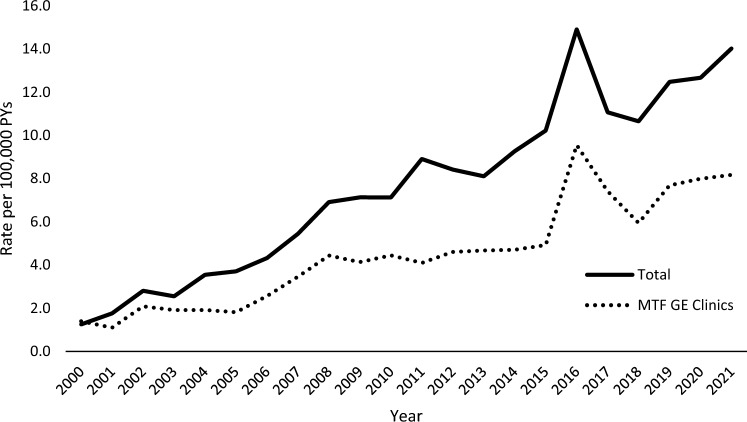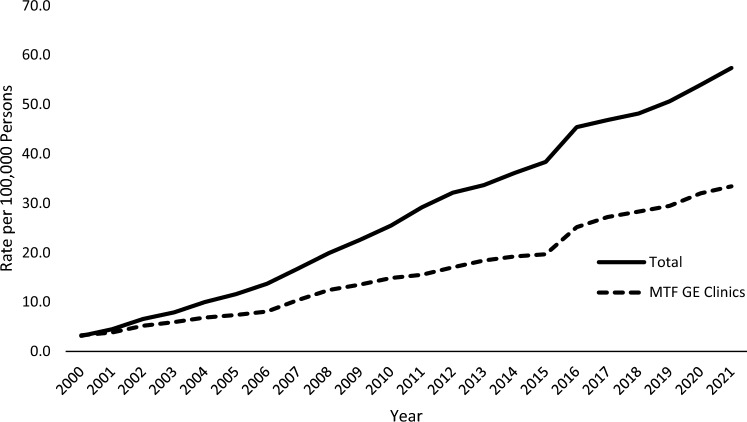
Click to Enlarge: Incidence of Celiac disease, active component service members, U.S. Armed Forces, 2000–2021 Source: Springer Nature
BETHESDA, Maryland — The incidence and prevalence of celiac disease increased significantly in the U.S. military population over the past two decades—a finding that has implications for operational readiness and the health of servicemembers.
That’s according to a new study led by researchers at Walter Reed National Military Medical Center. Researchers determined that celiac disease (CD)—an autoimmune disorder in which ingestion of gluten results in damage to the small intestine—affects approximately 1% of the global population and 1-2% of Americans. Incidence and prevalence within the U.S. military is posited to be higher than other population-based estimates.
“Given that this is a diagnosis that can preclude accession into the military and deployment to austere environments where dietary options are limited, we conducted a study to better define the epidemiology and impact of CD in the U.S. military population over a 22-year period,” the researchers wrote in Digestive Diseases and Sciences.1
The retrospective, population-based cohort study was based on data from the Defense Medical Surveillance System—a comprehensive data system capturing medical encounters of active duty military personnel from both military treatment facilities and civilian sources—from Jan. 1, 2000, through Dec. 31, 2021. The data analysis excluded activated reserve and guard members due to incomplete data capture. CD cases were identified through International Classification of Diseases (ICD) codes—ICD-9-CM (579.0) or ICD-10-CM (K90.0).
Over the 22-year study period, 2,248 military members received a new CD diagnosis, the study showed. The annual incidence rates of CD demonstrated a staggering increase—from 1.2 per 100,000 person-years in 2000 to 14.0 per 100,000 person-years in 2021. A similar pattern was observed within gastrointestinal (GI) specialty clinics, where CD incidence increased from 1.4 per 100,000 person-years to 8.2 per 100,000 person-years in the same timeframe. The prevalence also increased from 3.1 per 100,000 servicemembers in 2000 to 57.4 per 100,000 servicemembers in 2021. When stratified by GI clinic diagnosis, prevalence rates increased from 3.3 to 33.4 per 100,000 servicemembers.
Interestingly, the study found demographic variations in the incidence and prevalence of CD. “Rates in 2021 were higher in women, white-non-Hispanics and older age groups,” the researchers wrote. “By service, the Air Force had the highest incidence and prevalence rates in 2021, while the Marine Corps had the lowest.”
Increased Recognition?

Click to Enlarge: Lifetime prevalence of Celiac disease, active component service members, U.S. Armed Forces, 2000–2021 Source: Springer Nature
It was unclear whether the sharp increase in CD incidence and prevalence is due to an actual increase in disease burden or an increased recognition of disease, the authors stated. Although other studies indicate the most patients develop the disease in childhood, the new study showed an increase increasing age of diagnosis and incidence in adults. Also, despite the SARS-CoV-2 pandemic and decreased access to healthcare, incidence and prevalence rates of CD continued to rise in 2020 and 2021, they wrote.
While the study’s comprehensive approach sheds light on CD’s impact within the U.S. military, there are certain limitations the authors acknowledged. For example, reliance on ICD codes for diagnosis might lead to potential inaccuracies. The absence of biopsy specimens for confirmation also poses a limitation, although mitigated by the study’s use of a 6-month encounter criteria for inclusion.
The authors said such studies are important for the military, due to the requirements and constraints of military service. “In stark environments, gluten-free meals are not always available, and therefore CD is generally not compatible with deployment or accession to military service.” Previous research by the group showed an increase in food allergies in the military population, they noted. “This creates a potentially risky situation when members are unable to have control of their diet and ingredient (allergen) lists available.”
Identifying the increased rate of CD in the military highlights more awareness and research to identify potential mechanisms in pathogenesis, dietary research, and policies, the authors stated, adding, “the U.S. military population reflects a subset of the U.S. general population; given the increase with highest rates of diagnosis at later ages in this population, environmental factors such as vitamin D, diet, viral infections, antibiotic use and other factors should also be considered and studied further.”
- Lee RU, Stahlman SL, Magee JS. Celiac Disease on the Rise in the US Military Population: A 22 Year Retrospective Epidemiologic Study. Dig Dis Sci. 2023 Jul;68(7):3115-3118. doi: 10.1007/s10620-023-07964-8. Epub 2023 May 16. PMID: 37191782; PMCID: PMC10187517.

